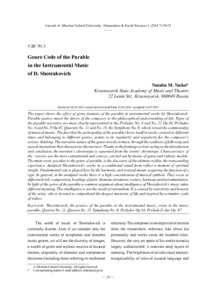Genre Code of the Parable in the Instrumental Music of D. Shostakovich
Скачать файл:
URI (для ссылок/цитирований):
https://elib.sfu-kras.ru/handle/2311/10181Автор:
Naiko, Natalia M.
Найко, Н.М.
Дата:
2014-01Аннотация:
The paper shows the effect of genre features of the parable in instrumental works by Shostakovich.
Parable poetics meets the desire of the composer to the philosophical understanding of life. Signs of
the parable narrative are most clearly represented in the Preludes No. 4 and No. 22 Op.34, Preludes
No. 4 and No. 9 Op.87, Quartets No. 11 and No. 15, the Symphony No. 9, which reveal the commonality
of musical means. The fact that the principality of the parable shows itself in works created at different
times and belonging to different genres, points to its regularity and organicity for the composer’s
artistic thinking. The narrative nature of the genre reveals in music through the synthesis of folk-song and
speech intonations that characterize the narrator. Thanks to the framing sections acting as the introduction
and conclusion, the narrator’s chronotope is separated from the events’ chronotope. Characteristics of
the “actors» are the most conventional and concise, carried out by means of genre and stylistic models.
The main event, peculiar to the genre of parable, is the discovery of the ultimate reality, the transcending
experience. Analyzed Shostakovich’s works in a conditional sound form reflect a moment of spiritual
insight. Fundamental role is played here by the harmonic and textural means acquiring the function of a
sign. In general, in the analyzed works there is a high concentration of musical symbols. They occur at
different levels: composition, headings of parts, thematic inventions, texture, harmony and instrumentation.
In light of the genre of the parable a common argument about intelligence of Shostakovich’s music takes
different meaning. This intelligence is not the result of rationalism. It is caused by sensitivity and honesty
of the artist, who is devoted to comprehend the deepest mysteries of life and inspired by a timeless scale
of values В статье показано действие жанровых особенностей притчи в инструментальных
сочинениях Д. Шостаковича. Притчевая поэтика отвечает стремлению композитора к
философскому осмыслению жизни. Признаки притчевого повествования наиболее ярко
представлены в прелюдиях № 4 и 22 op.34, прелюдиях №4 и №9 op. 87, квартетах № 11 и 15,
симфонии № 9, где обнаруживает себя общность музыкальных средств. Тот факт, что
притчевое начало являет себя в произведениях, созданных в различное время и принадлежащих
разным жанрам, указывает на его закономерность и органичность для художественного
мышления композитора. Повествовательная природа жанра раскрывается в музыке через
синтез народно-песенных и речевых интонаций, характеризующих рассказчика. Благодаря
обрамляющим разделам, выполняющим функции вступления и заключения, хронотоп
повествователя отделяется от событийного хронотопа. Характеристики «действующих
лиц» предельно условны и лаконичны, осуществляются посредством жанровых и стилевых
моделей. Главное, специфическое для жанра притчи событие – обнаружение высшей
реальности, переживание опыта трансцендирования. В рассмотренных сочинениях Д.
Шостаковича в условной звуковой форме отображается момент духовного прозрения.
Основополагающую роль при этом играют гармонические и фактурные средства,
приобретающие знаковую функцию. В целом в анализируемых произведениях наблюдается
высокая концентрация музыкальных символов. Они возникают на разных уровнях:
композиции, заголовков частей, тематизма, фактуры, гармонии, инструментовки. В свете
жанра притчи иной смысл приобретает распространенный тезис об интеллектуальности
музыки Шостаковича. Эта интеллектуальность не есть следствие рационализма. Она
обусловлена чуткостью и честностью художника, призванного к постижению глубочайших
тайн бытия, ориентированного на вневременную шкалу ценностей
Коллекции:
Метаданные:
Показать полную информациюСвязанные материалы
Показаны похожие ресурсы по названию, автору или тематике.
-
Musical Interests and Priorities of Vladimir Lenin (Modern Vision)
Preisman, Emil’ M.; Прейсман, Э.М. (Сибирский федеральный университет. Siberian Federal University, 2015-06)In modern Russia the problem of cultural education, including musical and aesthetic one, has become quite acute as one of the barriers on the way of globalization negative impacts. After Perestroika, the work on cultural ... -
Musical Life of Krasnoyarsk in the 60-s of the XX Century
Preisman, Emil M.; Прейсман, Э.М. (Сибирский федеральный университет. Siberian Federal University., 2016-09)The article discusses the musical life of Krasnoyarsk as the country’s art culture component. Analysis of the activities of the Krasnoyarsk Regional Philharmonic, the Theatre of Musical Comedy, the School of Art, and ... -
Музыка перед вызовами цифрового общества
Марков, Б. В.; Ярочкин, Д. А.; Markov, Boris V.; Yarochkin, Dmitriy A. (Сибирский федеральный университет. Siberian Federal University, 2021-06)В статье реконструируется ряд установок и предпосылок как создания, так и восприятия музыки, которые являются предметом когнитивно-антропологического анализа музыки. Другой теоретический мотив – необходимость различия ... -
Coloristic Properties of Piano Music Texture in Nikolai Medtner’s Works
Budnikov, Vladimir V.; Будников, В.В. (Сибирский федеральный университет. Siberian Federal University, 2016-06)This article focuses on the research of colour as applied to N. Medtner’s piano works. It discusses the composer’s views on brilliance of colour, “sonority” (звучность) of music and texture as one of its most important ... -
On the Concept of Musical Performance
Beniumov, Mikhail I.; Бенюмов, М.И. (Сибирский федеральный университет. Siberian Federal University., 2014-03)The paper focuses on the controversy term of “performance”. There was given a range of definitions of the term at different levels of commonness and specificity: performance as a kind of activity; performance as a part ...

